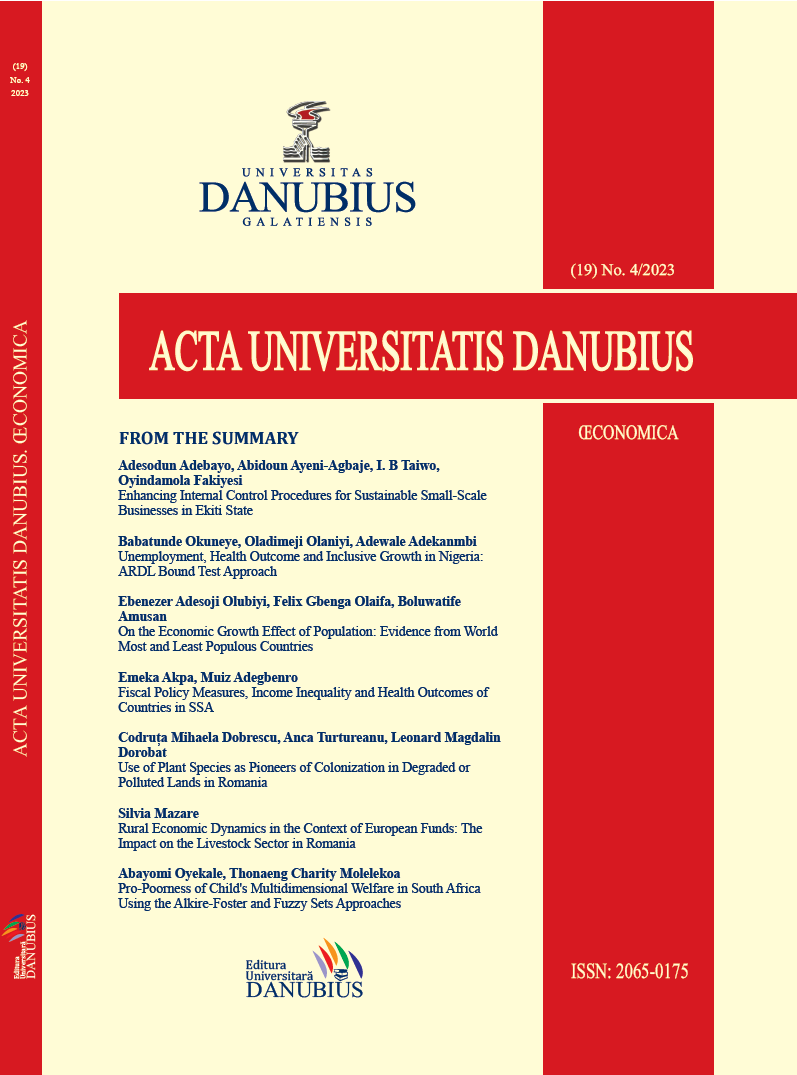Pro-Poorness of Child’s Multidimensional Welfare in South Africa Using the Alkire-Foster and Fuzzy Sets Approaches
Abstract
The multidimensional notion of poverty has been widely emphasized in development economic literature. However, very little is known on pro-poorness of children’s multidimensional welfare in South Africa. This study therefore analyzed multidimensional welfare indicators of South African children and their pro-poorness. The data were the General Household Survey (GHS) for 2017, 2018 and 2019. Child’s poverty indicators were computed with Alkire-Foster and fuzzy set approaches. These were transformed into multidimensional wealth indicators (MWIs) and analyzed using the pro-poor growth index (PPGI) and poverty equivalent growth rate (PEGR). The results revealed that the fuzzy MWI were pro-poor between 2017 and 2018 with PPGI of 1.33, 1.84 and 2.56 for poverty incidence, depth and severity, respectively, but only pro-poor for poverty incidence in 2018/2019 with PPGI of 1.714. The fuzzy MWIs were largely pro-poor among Black/African and White children and those who resided in traditional areas between 2017 and 2019. It was concluded that although interventions to reduce poverty in South Africa had shown some level of pro-poorness, multidimensional poverty is still high among children. Also, analysis of pro-poor growth with multidimensional approach is highly sensitive to the adopted welfare computation methodology.
References
Alkire, S., and Foster, J. (2011). Counting and multidimensional poverty measurement. Journal of public economics, 95(7-8), 476-487.
Bird, K. (2013). The intergenerational transmission of poverty: An overview. Chronic poverty, 60-84.
Dingela, S., & Khobai, H. (2017). Dynamic impact of money supply on economic growth in South Africa. An ARDL approach.
Dladla, L. G. (2020). Persistent Youth Unemployment: The Role of Public Employment Programme and Green Jobs-A Case of the Western Cape Province, South Africa. African Journal of Governance and Development, 9(2), 472-492.
Etim, E., & Daramola, O. (2020). The informal sector and economic growth of South Africa and Nigeria: A comparative systematic review. Journal of Open Innovation: Technology, Market, and Complexity, 6(4), 134.
Kakwani, N., and Pernia, E. M. (2000). What is pro-poor growth? Asian Development
Kakwani, N., and Son, H. H. (2008). Pro-poor growth: the Asian experience. In Globalization and the Poor in Asia (pp. 24-46). Palgrave Macmillan, London.
Leshoro, T. L. (2017). An empirical analysis of disaggregated government expenditure and economic growth in South Africa.
Mahadea, D., & Zogli, L.K.J. (2018). Constraints to growth in informal sector activities and formalisation: A case study of Ghanaian slums. The Southern African Journal of Entrepreneurship and Small Business Management, 10(1), 1-9.
Ndhleve, S., Obi, A., & Nakin, M. D. V. (2017). Public spending on agriculture and poverty in Eastern Cape Province, South Africa. African Studies Quarterly, 17(2), 23-46.
Ngumbela, X. G. (2021). Unique Challenges of the Poverty Dilemma in the Eastern Cape Province of South Africa. African Journal of Public Affairs, 12(1), 114-131.
Parliament (2021). Social grant performance as at end March 20/21. Available online: https://www.parliament.gov.za/storage/app/media/PBO/National_Development_Plan_Analysis/2021/june/03-06-2021/May_2021_Social_Grant_fact_sheet.pdf (accessed on 5th December 2022).
Omotoso, K. & Koch, S.F. (2017). Exploring Child Poverty and Inequality in Post-Apartheid South Africa: A Multidimensional Perspective, Working Paper. Pretoria: University of Pretoria.
Pasara, M. T., & Garidzirai, R. (2020). Causality effects among gross capital formation, unemployment and economic growth in South Africa. Economies, 8(2), 26.
Setokoe, T. J. (2021). Community-based tourism: A panacea for community development in nqileni village, eastern cape, south africa. Geo Journal of Tourism and Geosites, 34(1), 28-32.
Shakouri, B., & Khoshnevis Yazdi, S. (2017). Causality between renewable energy, energy consumption, and economic growth. Energy Sources, Part B: Economics, Planning, and Policy, 12(9), 838-845.
Statistics South Africa (2015). Child poverty in South Africa: A Multiple Overlapping Deprivation Analysis Overview of the multi-deprivation index on children. https://www.parliament.gov.za/storage/app/media/Pages/2021/november/17-11-2021_parliament_unicef_webinar/presentations/2_StatsSA_Child_Poverty_Draft2_11_11_4pm_shortened.pdf
Statistics South Africa. (2018). Men, Women & Children: Findings from the Living Conditions Survey, 2014/15. Pretoria: Statistics South Africa.
Sunde, T. (2018). The interaction of energy consumption and economic growth in South Africa: assessment from the bounds testing approach. International Journal of Sustainable Economy, 10(2), 170-183.
UNICEF (undated). Child Poverty. Available online: https://www.unicef.org/social-policy/child-poverty Accessed 07/06/2023.
UNICEF. (2005). The state of the world's children 2006: excluded and invisible. Unicef.
World Bank. (2020). World development report 2020: Trading for development in the age of Global Value Chains.
World Bank, UNICEF 2022. The Impact of COVID-19 on the Welfare of Households with Children. Washington, DC: World Bank. License: Creative Commons Attribution CC BY 3.0 IGO.
Downloads
Published
How to Cite
Issue
Section
License
Copyright (c) 2023 Abayomi Oyekale, Thonaeng Charity Molelekoa

This work is licensed under a Creative Commons Attribution-NonCommercial 4.0 International License.
The author fully assumes the content originality and the holograph signature makes him responsible in case of trial.


